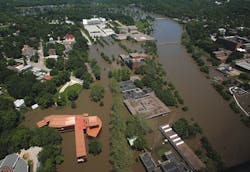Flood of 2008: The University of Iowa
"I‘ll never look at winter the same," says Rod Lehnertz, the University of Iowa's director of planning, design, and construction, reflecting on the Flood of 2008. What started as a cold, record-breaking, snow-white winter turned into the most devastating natural disaster the University of Iowa (UI) has ever faced.
Like many of the buildings profiled in this section, the UI, located in Iowa City, IA, had its own challenges when it came to flood preparation and recovery: The campus is flanked by the Iowa River and has a reservoir immediately north of its campus (the Coralville Lake).
"Because of a wet winter, and then a wet spring, the reservoir was filling higher than normal," explains Ken Lloyd, associate director of utilities at the UI. "As of late April, the Army Corps of Engineers, which regulates the Coralville Lake, was discharging about 10,000 cubic feet per second out of the lake - the maximum normal discharge prior to May 1." When the discharge rate reaches 12,000 cubic feet per second, Dubuque Street - the main thoroughfare through campus, and the only way to access Mayflower, the campus' largest residence hall - becomes submerged in water. "In mid May, the big debate was: ‘Do we need to sandbag Mayflower prior to the end of the semester?' The decision was made not to sandbag or evacuate Mayflower because there still was capacity left in the reservoir for additional pool elevation," explains Lloyd. The semester ended, students left, and it looked like conditions on campus were improving due to drier weather. But, in the final week of May, the rain returned with a vengeance. The UI's flood emergency response plan, which was developed after the Flood of 1993, was put into action on June 3. "We sent the evacuation order out on the first day of classes for summer session - not the way you want to start your summer," says Don Guckert, associate vice president and director of facilities management at the UI.
Familiar with what can happen in a flood situation due to flooding in 1993, the team feared that the reservoir was going to fill to the tipping point. "After the first week of June, we began declaring red alerts on campus and moving forward to protect facilities," says Lloyd. No one knew that the floodwaters about to move in on campus would be much worse than those from 1993. No one thought that was even possible.
"The plan defined the roles of different departments, had instructions on how to build dikes and how high to build them, etc.," explains Guckert. "We had a flood plan. It just didn't anticipate a flood of this magnitude."
Putting a Plan into Action
Beginning the first week in June, the UI began building its dike system. With each day that passed, the team received revised forecasts about expected water levels - and the predictions became more ominous. "Every day, for almost a 10-day period, we were building our dikes and protection systems higher and higher, based on gloomier predictions. The Corps might say, ‘Expect a 1-foot rise between now and tomorrow.' Later in the day, they'd revise the projection because of what was going on upstream in terms of rain in other communities," explains Guckert. In some cases, dike systems were built three times based on increasing water-level predictions. Due to the way dikes are built (according to the UI's plan, for every 1 foot in height, you need 3 feet in width), a 2-foot-tall sandbag wall built one day would need to be replaced with a Jersey barrier (made of precast concrete) the next day. A day or two later, that Jersey barrier would need to come down and be replaced by a HESCO barrier (collapsible mesh containers with fabric lining that can hold sand, dirt, or gravel) ... all to keep up with rising floodwaters.
During the second week of June, the UI started working with local media to put out a call for volunteers. It also set up a blog that kept employees, students, and community members in the loop about current conditions, where departments and classes were relocating to, etc. Staff members worked with the state's emergency response team and the Army Corps of Engineers to take in the information being collected and respond accordingly. At this point, most of the FM team had assumed roles beyond their typical responsibilities. Staff members were charged with securing movers for assets being removed from buildings; coordinating volunteer work; organizing the inventory, deployment, and fueling of temporary generators and pumps; and serving as "communication hubs," linking people on campus to the resources they needed. Daily flood meetings were also held. Between 50 and 70 people met 7 days a week to discuss status updates, upcoming work, and the next steps.
Not only was the river that runs through the campus raging and rising, threatening the campus' buildings and infrastructure, but it also posed another problem: It was threatening to divide the campus in half. "The bridges along the Iowa River were being topped in some areas and serving as dams in other areas. The water was hitting the bridge steel, and debris was collecting; there was increasing risk that the bridges would be lost. How would you continue to respond to a flood if your campus is cut apart?" asks Guckert. Luckily, the river cooperated, and a few bridges remained above water, allowing people to move back and forth across campus.
The UI wasn't so lucky, however, in terms of a major roadway that connects it to other parts of the state. "[In terms of flood conditions], we're behind the Cedar River and Cedar Rapids, so we had employees who couldn't get here because of road closures between Cedar Rapids and Iowa City. We were dealing with equipment that couldn't get here. So, what's happening at the next community and the next river over had an impact on us that we didn't foresee," says Guckert.
On Saturday, June 14, more than 2,000 volunteers were on campus. "That was the last push against the crest of the flood," says Lehnertz. "It was a tough day because we lost our power plant at 2 a.m. But, more volunteers than we could've ever imagined showed up that day. It was remarkable."
The Iowa River crested at 31.5 feet on Sunday, June 15; the next day, the UI president announced that summer classes would start 1 week later.
The Road to Recovery
Recovery efforts at the UI began even before floodwaters crested. "We started to order critical equipment and replacement components for buildings that we needed to get online, like a 1,000-bed residence hall, three classrooms, and a library," says Guckert. Thanks to the utilities and energy management department, teams were able to assemble two mini power plants within 3 days. "We were able to get minimal, acceptable levels of steam generation on our campus to be able to power up our buildings and allow most of the campus to work 1 week after the floods for the summer semester. But, we still had 30,000 students scheduled to come to campus on Aug. 18," says Lehnertz.
The campus needed to be ready for the fall semester. "To do so, we had to bring four critical buildings online," says Lehnertz, "and all four had a completion date of Aug. 15 - 3 days before the students would come back. We brought consultants in and started construction within 2 weeks of the flood," says Lehnertz.
Two recovery firms were brought in to begin the process of "mucking out," says Dan Heater, director of building and landscape services at the UI. "Then, the clean-up processes started, which included the removal of sheetrock, plywood, furniture that may have been wet, etc. Once they did the general mucking out, they started to sanitize so we could get in and work in those areas." As the recovery firms worked, Lehnertz says the process was incredible to watch. "You could go into these buildings after they had taken the bottom 4 feet of the walls off, leaving nothing but the steel studs left onto the concrete floor. You would see dozens of workers with chemical cleaners and toothbrushes, scrubbing the inside and outside corners of every steel stud in the entire building."
All four buildings were completed on Aug. 15, ready for incoming students. According to Guckert, close to $3 million in work was done to two classroom buildings in 35 days; $1 million in classroom repairs were completed within 3 weeks. "The good news: We're operational. We brought back half of the space that was idled. The bad news: The other half of the space will take much longer and cost much more because there's that much more damage."
As recovery efforts move forward, the team plans to revisit its flood emergency response plan. They've also hired a flood-mitigation consultant to help protect against future risks. "We're going to identify some of the activities we need to engage in besides putting up dikes. The plan is going to discuss the kind of pumping requirements we need, protective devices we need to keep storm sewers from flooding, etc.," explains Lloyd. The plan will also include trigger points for evacuation.
With help from another outside firm, the UI also plans to interview employees to find out how each building was breached. "Where did it happen? How did it happen? Was it water coming out of the banks of the river? Was it a manhole that burst from underneath? Was water coming up through the building itself? We'll be interviewing people who were stepping out of the buildings at the last minute to find out," says Lehnertz.
When all was said and done, 20 major buildings on the UI campus were affected - 2.8 million square feet of a 16 million-square-foot campus were out of operation. Even though the majority of campus was on higher ground and didn't experience flooding, almost every building dealt with interrupted utility service due to the tunnel distribution system and flooded power plant. The level of damage across campus varied: "There could've been 6 inches of water that took out one building, like our 340,000-square-foot library, or it could be like Hancher Auditorium, where there was water everywhere that took that building out of operation," explains Guckert. With the opening of its fall semester on Aug. 18, the UI had half of those 2.8 million square feet back in use.
Looking Back (and Forward)
The facilities management team is proud of its accomplishments - and it should be: The campus saved more in terms of building assets than what was damaged. "We're very satisfied with how we responded to this disaster, even though the disaster eventually overtook many of our efforts," says Guckert.
The team has some work ahead. Its steam plant still isn't fully operational. The target date for completion: Nov. 1. For now, temporary boilers exist on each side of the river. "We're working toward getting our solid fuel boilers online. Water damaged the insulation on the steam pipes, so that is being replaced. It also did structural damage to the pipes. We still have a way to go to get our reliability back up to where we'd like to be," says Glen Mowery, the UI's director of utilities and energy management. But, as of press time, the team was working hard to meet the Nov. 1 deadline.
Although the UI's flood emergency response plan didn't address the water levels it experienced during the Flood of 2008, Guckert still says the plan helped tremendously, and credits it for the team's success: "I'd be the first to admit that, 3 or 4 months ago, I had a lot to do other than go through the preparation of a response plan. But, having a response plan, and drilling through it, paid dividends."
More Flood Stories:
-
Mercy Medical Center - By Jana J. Madsen
-
Alliant Energy Tower - By Jenna M. Aker
-
The University of Iowa - By Leah B. Garris
-
City of Cedar Rapids - By Jenna M. Aker
-
Guaranty Bank & Trust - By Linda K. Monroe
-
Quaker Oats - By Jana J. Madsen
-
Cedar River Tower - By Linda K. Monroe
Leah B. Garris ([email protected]) is managing editor at Buildings magazine.



